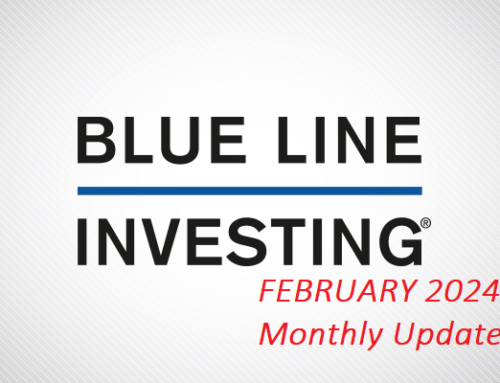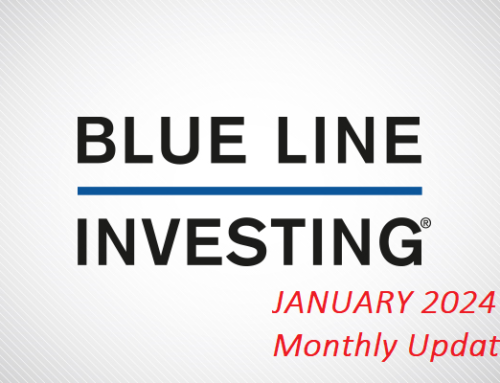
Blue Line Investing, Article 6 of 12
When playing poker it can be advantageous if you can learn the “tell” of your opponent. A tell is defined by Wikipedia as “a change in a player’s behavior or demeanor that is claimed by some to give clues to that player’s assessment of their hand. A player gains an advantage if they observe and understand the meaning of another player’s tell, particularly if the tell is unconscious and reliable.” We believe the stock market has its own tell, but how can its reliability be determined? We believe the answer is to look at witnesses!
When money moves in the stock market it typically flows out of one sector and into another. These changes in the bid and ask price for an investment are what causes prices to rise and fall over time. For instance, historically, when stocks have a price correction, symbolized by more selling than buying, you may observe other sectors like bonds rising as they become the recipient of that money (at least in the short term). While these historical relationships are not absolutes, they help illustrate the concept.
In recent weeks we have observed the stock market from the Daily perspective, which suggested a negative outcome (at least in the short term). The resulting price correction led to a successful “test” of the price breakout which we observed when looking at the Weekly perspective (the intermediate term). With the successful test, we believed the market was suggesting a further rise in price. But the Monthly perspective (long term) seemed to suggest caution. So where else can we look for two or more witnesses in hope of correctly determining the potential reliability of the markets tell?
One witness may be observing the price action and behavior in other sectors, like U.S. Government Bonds. As mentioned above, when investors become concerned they typically seek safety. A second witness may be observing another type of investment within the same sector, like high-yield, or “junk” bonds. Since they behave more like the stock than bond market, their behavior may shed more light on expectations for the next potential move in the stock market. A third witness may be observing a volatility investment like the exchange-traded fund (ETF) VXX. After all, when knowledgeable investors begin to get nervous, they might buy put options and sell call options as a defensive strategy. Some of this behavior can be observed by monitoring the VXX ETF.
By monitoring all these witnesses in unison we are better able to evaluate the reliability of what we perceive to be the market’s tell. It is important to keep in mind that when prices make dramatic moves in the stock market, it doesn’t typically happen in isolation and without advance notice. If you can learn to read the market’s tell, then we believe over time you are likely to make more profitable than unprofitable investment decisions.
In our next article we will revisit the concept of diversification.
Disclaimer:
Technical analysis is a method of evaluating securities by analyzing statistics generated by market activity, such as past prices and volumes. Technical analysis attempts to predict a future stock price or direction based on market trends. The assumption is that the market follows discernible patterns and if these patterns can be identified then a prediction can be made. There are certain limitations to technical analysis research, such as the risk is that markets may not always follow patterns. This investment process should not be considered a guaranteed prediction of market activity and is one of many indicators that may be used to analyze market data for investing purposes. There is no guarantee that this process will be successful or will result in the projections contained herein.
Past performance is not indicative of future results. This material is intended for educational purposes only and is not financial advice or an offer to buy or sell any product. The investment strategy discussed may not be suitable for all investors. Investors must make their own decisions based on their specific investment objectives and financial circumstances. The opinions expressed are those of Blue Line Investing and are not necessarily those of Gordon Asset Management, LLC and are subject to change without notice. Blue Line Investing reserves the right to modify its current investment strategies based on changing market dynamics or client needs. Advisory services offered through Gordon Asset Management, LLC (GAM). GAM is an SEC-registered investment adviser. Registration does not imply a certain level or skill or training. More information about the advisor, its investment strategies and objectives, is included in the firm’s Form ADV Part 2, which can be obtained, at no charge, by calling (866) 216-1920. The principle office of Gordon Asset Management, LLC is located at 1007 Slater Road, Suite 200, Durham, North Carolina, 27703.
The iPath® S&P 500 VIX Short-Term Futures™ ETNs (the “ETNs”) are designed to provide exposure to the S&P 500 Index VIX Short-Term Futures™ Index Total Return (the “Index”). The Index is designed to provide access to equity market volatility through CBOE Volatility Index® (the “VIX Index”) futures.




